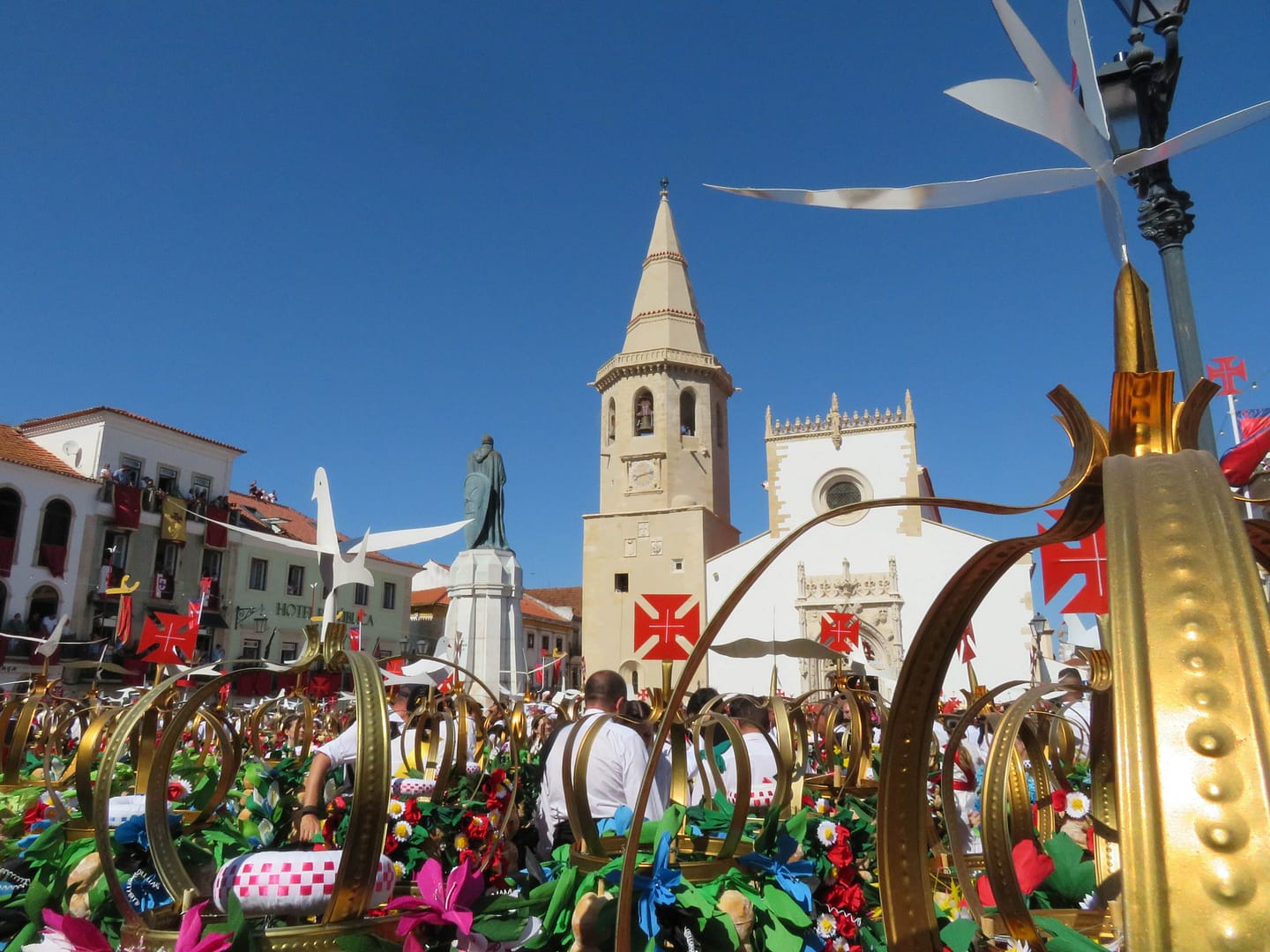With so much to see and do, it’s no wonder that Portugal was just named Europe’s Leading Destination at the 30th World Travel Awards. While most visitors focus on the country’s most popular tourist regions like the Algarve for its beaches or the Douro Valley for its vineyards, Central Portugal is an area that is sometimes overlooked. Boasting incredible UNESCO World Heritage Sites, stunning scenery, incredible food and drink, not to mention friendly and welcoming residents, savvy travellers have been coming here for years to experience some incredible attractions, like these 10 outstanding examples.
Table of Contents
Witness the spectacular festival of the trays
Imagine balancing the weight of two bowling balls on your head while walking six kilometres in the sweltering summer heat and you’ll get an idea of what it’s like for the women who walk in one of the world’s most unique religious processions, the Festa dos Tabuleiros in Tomar, Portugal. Held only once every four years to mark Pentecost, the seventh Sunday after Easter, this one-of-a-kind event attracts tens of thousands of spectators from around the world. They line the narrow streets of this small city in central Portugal to witness a colourful celebration that has roots dating back to at least the 14th century, if not earlier.
Visit where the shepherd children saw the Virgin Mary
The Shrine of Our Lady of Fátima where Catholics believe that the Virgin Mary appeared before three young shepherds in 1917 is probably central Portugal’s most famous pilgrimage site, but the sheer scale of the place has to be seen to be believed. With its striking architecture and beautiful artwork, including the renowned “Crown of the Virgin” sculpture atop its central tower, The Basilica of Our Lady of the Rosary is the most notable structure on the site, but The Chapel of the Apparitions is probably the most important. This small chapel marks the exact spot where the Virgin Mary is believed to have appeared before Lucia dos Santos and her cousins Jacinta and Francisco Marto, on multiple occasions between May and October 1917. The chapel is a focal point for prayer and reflection for millions of faithful every year.
Pay your respects at Portugal’s Tomb of the Unknown Soldier
Tucked away in the UNESCO World Heritage Site of The Monastery of Batalha, visitors will find Portugal’s Tomb of the Unknown Soldier. The spectacular hall that houses this monument actually contains the tombs of two unknown soldiers from the First World War, one from the Western Front and the other from battles defending Portuguese colonies in Africa. To this day, soldiers watch over the tombs and visitors can witness the solemn ceremony of the changing of the guards every hour. For more context of this period of the nation’s past, there is an extensive collection of artefacts explaining the country’s First World War history.
Explore the masterpiece that is the Monastery of Alcobaça
This Cistercian monastery that was founded in the 12th century is a masterpiece of Gothic and Baroque architecture and was an important cultural, religious and political centre for centuries, but what people remember it for the most is its connection to the tragic love story of King Pedro I and Inês de Castro. Inês was a lady-in-waiting to Pedro’s wife Constance, but he was in love with her and they would meet in secret. When his wife later died, they moved in together, but this angered his father, King Afonso IV, who ordered her killed. When Pedro eventually became king, he sought revenge on Inês murderers by having their hearts torn out, declared her the rightful queen and moved her body to a tomb in the monastery that visitors can see today. Her stone coffin lies across from Pedro’s and each is topped by reposing sculptures of the two monarchs and a wealth of intricate carvings depicting their life stories that are some of the finest examples of funerary art anywhere.
Wander the halls of the Monastery of Batalha
The Monastery of Batalha’s original name is the Monastery of Santa Maria da Vitória. If you translated both names into English they would be The Monastery of Holy Mary of Victory and the Monastery of Battle, both clues as to the origins of this dazzling Gothic architectural marvel. It would take 150 years to complete the job, but King João I began work on this sprawling collection of buildings to thank the divine powers for his victory in the Battle of Aljubarrota in 1385. The battle has great symbolic significance in Portuguese history as it cemented its position as an independent nation.
Discover the Convent of Christ in Tomar
On a hill overlooking the charming town of Tomar sits a towering 12th-century convent adjacent to a Templar castle that was once home to Prince Henry the Navigator, an important figure during the Age of Discovery when Portuguese explorers set out to map the world. The convent was built over many centuries so it is a riot of architectural styles ranging from Romanesque to Gothic and Renaissance to Baroque, but it all combines to make something magnificent. Inside, visitors can learn what life was like in the convent and marvel at the beauty of its interiors.
Walk the ramparts of the Castle of Óbidos
The picturesque town of Óbidos with its narrow cobblestone streets lined with whitewashed houses adorned with colourful flowers is worth visiting in its own right, but what truly makes this place spectacular is the Castle of Óbidos. Perched on a hill overlooking the town, this medieval 12th-century fortress offers stunning views of the town and countryside below. You can walk along the old fortress walls and explore the castle interior. It hosts concerts and other events throughout the year, but it’s especially popular to visit every July when it hosts its annual medieval fair.
Walk the Portuguese Way
Walking the Camino de Santiago, which is known in English as the Way of St. James, has become a popular activity for people looking to experience the world at a slower pace and maybe use some of that time for inner reflection. The ancient Christian pilgrimage route is mostly associated with Spain since it ends in Galicia, but there are feeder routes from France and Portugal. The Camino Portugués, or Portuguese Way crosses into Spain at Valença. To get there, you can either start at the cathedral in Lisbon (for a total walking distance of about 610 km) or at the cathedral in Porto in the north of Portugal (for a total of about 227 km). All roads lead to the cathedral Santiago de Compostela where tradition holds that the remains of St. James the apostle are buried.
Hang ten on the world’s largest waves in Nazaré
Nazaré is a beautiful beach town that attracts visitors to its golden sands all year round, but what it is most famous for are some of the world’s largest waves. When conditions are right, usually during the winter months, the world’s top surfers challenge themselves against the monster waves that crash along the Praia do Norte. The best place to see the waves in action is from the lighthouse perched on top of Sāo Miguel Arcanjo fort. While there you can visit the surf museum and learn how the massive waves are formed by an underwater canyon that lies just offshore.
Go birdwatching in the Lagoa de Óbidos
The calm and warm waters of the Óbidos Lagoon, the longest on the Portuguese coast, are a stark contrast to the mighty waves of the Atlantic Ocean that can be found a short distance away. It is also home to a fascinating ecosystem which is a paradise for birdwatchers who come to see flamingoes and other colourful avian species. You can spot them by walking or biking along the shore, but one of the best ways to do it is by boat. The shallow waters of the lagoon are easy to navigate whether you are sailing, paddleboarding or kayaking.




